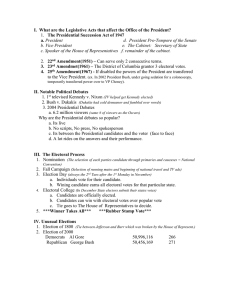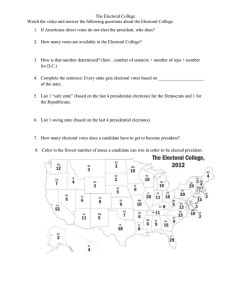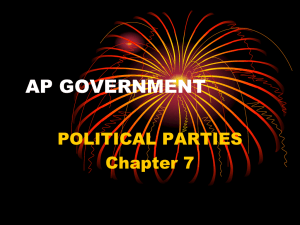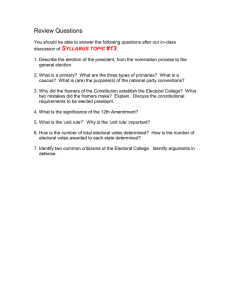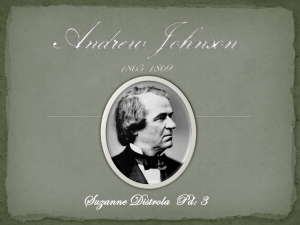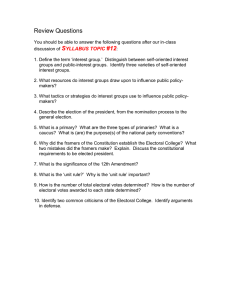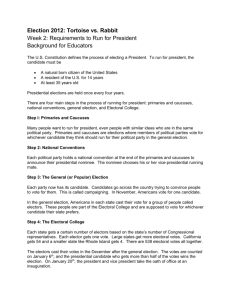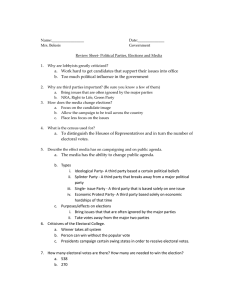FIRST a. schools b. family ... 46) Childhood learning is important to socialization because
advertisement
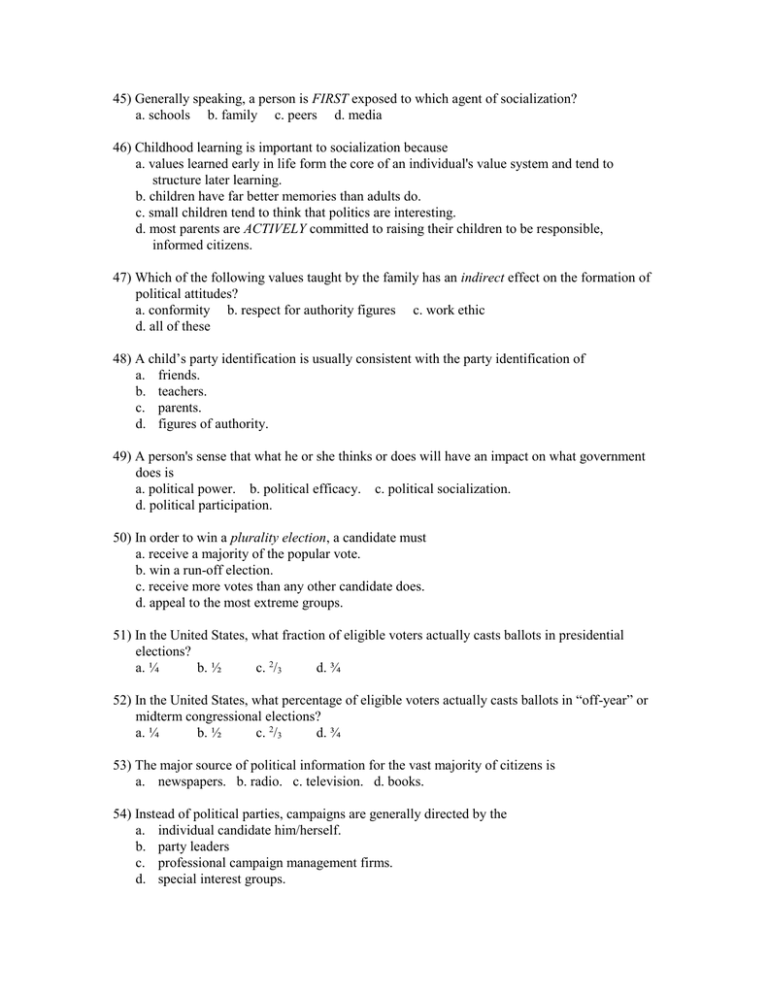
45) Generally speaking, a person is FIRST exposed to which agent of socialization? a. schools b. family c. peers d. media 46) Childhood learning is important to socialization because a. values learned early in life form the core of an individual's value system and tend to structure later learning. b. children have far better memories than adults do. c. small children tend to think that politics are interesting. d. most parents are ACTIVELY committed to raising their children to be responsible, informed citizens. 47) Which of the following values taught by the family has an indirect effect on the formation of political attitudes? a. conformity b. respect for authority figures c. work ethic d. all of these 48) A child’s party identification is usually consistent with the party identification of a. friends. b. teachers. c. parents. d. figures of authority. 49) A person's sense that what he or she thinks or does will have an impact on what government does is a. political power. b. political efficacy. c. political socialization. d. political participation. 50) In order to win a plurality election, a candidate must a. receive a majority of the popular vote. b. win a run-off election. c. receive more votes than any other candidate does. d. appeal to the most extreme groups. 51) In the United States, what fraction of eligible voters actually casts ballots in presidential elections? a. ¼ b. ½ c. 2/3 d. ¾ 52) In the United States, what percentage of eligible voters actually casts ballots in “off-year” or midterm congressional elections? a. ¼ b. ½ c. 2/3 d. ¾ 53) The major source of political information for the vast majority of citizens is a. newspapers. b. radio. c. television. d. books. 54) Instead of political parties, campaigns are generally directed by the a. individual candidate him/herself. b. party leaders c. professional campaign management firms. d. special interest groups. 55) Primary elections in which a voter may cast a ballot in both parties’ primaries are a. closed primaries. b. open primaries. c. blanket primaries. d. general elections. 56) A person who votes for candidates of different parties for different offices in a general election is called a. maverick. b. absentee voter. c. ticket splitter d. party activist. 57) An electoral system that allocates seats in a legislature based on proportion of votes the parties receive in a national election is a. equal representation. b. bipartisan representation. c. proportional representation. d. disproportionate representation,. 58) Individuals and organizations that contribute to candidate campaigns show a strong preference for a. members of Congress over state legislators. b. incumbents over challengers. c. Republican candidates over Democratic candidates. d. Democratic candidates over Republican candidates. 59) It is widely believed that television’s focus on personal character and private lives – rather than on policy positions and governmental experience – encourages a. More qualified candidates to run for office. b. negative campaigning. c. muckraking coverage. d. campaign exposes. 60) The most expensive aspect of the campaign is a. recruiting talented staff. b. renting centralized office space. c. paying professional staff. d. television advertising. 61) Political contributions to a party for activities such as party-building or voter registration, but not directly for campaigns is called a. quiet money. b. soft money. c. party money. d. hush money. 62) People who perceive the economy as getting worse are likely to vote against the while people who think the economy is getting better support the ___ . _____, a. b. c. d. challenger, incumbent. incumbent, challenger. challenger, challenger. incumbent, incumbent. 63) The Constitution provides that a candidate must receive a majority of Electoral College votes to be elected president. There are a total of 538 electoral votes. How many electoral votes (minimum) must the winning candidate receive? a. 254 b. 270 c. 538 d. at least one more than any other candidate 64) What happens if no presidential candidate receives a majority of the Electoral College vote? a. There is a run-off election. b. The president is elected by the House of Representatives. c. The president is elected by the Senate. d. The entire process must start over, beginning with the nomination of new candidates by the two major parties. 65) In the Electoral College, each state is accorded a number of electoral votes a. equal to the number of the state's senators and representatives in Congress. b. equal to the number of delegates it sends to the national party conventions. c. equal to the number of representatives in the state legislature. d. equal to the number of registered voters in the state. 66) Suppose that in the presidential election in the year 2004, the Republican Party’s candidate gets 20 million popular votes and 241 electoral votes. The Democratic party’s candidate receives 18 million popular votes and 265 votes in the Electoral College. The Green Party’s candidate manages to get 16 million popular votes and 32 votes in the Electoral College. Who becomes president? a. the Republican b. the Democrat c. the Green candidate d. cannot be determined given the above facts. 67) The Electoral College operates according to the "unit rule." The "unit rule" a. is prescribed by the Constitution. b. increases the chances that no candidate will receive a majority of the electoral vote. c. encourages third party candidates. d. means that all of a state's electoral votes go to the candidate who won a plurality of the popular vote. 68) More than influencing policy, political parties are concerned with a. recruiting people to hold positions in the party organization. b. winning public office in elections. c. soliciting funds from large corporations. d. selecting the site for the next presidential nominating convention. 69) One of the two main parties in American politics which traces its origins to the antislavery and nationalist forces that united in the 1850s is now the a. American-Republican Party. b. Federalist Party. c. Democratic Party d. Republican Party 70) Despite the erosion of many of their functions, American’s political parties survive as the principal institutions for a. running campaigns. b. recruiting candidates. c. organizing elections. d. raising campaign funds. 71) A statement of principles adopted by a political party at its national convention is the a. statement of party procedures b. party’s writ of principles. c. party’s platform. d. party’s planks. 72) The approximate percentage of eligible Texans who voted for governor in 1998 was a. ¼ b. ½ c. 2/3 d. ¾ 73) Which of the following is not likely to be a factor in low voter turnout in Texas? a. low levels of campaign spending by candidates b. too many and too frequent elections c. negative campaigning d. feelings of isolation from government 74) Primary elections in Texas are classified as a. blanket primaries. b. open primaries. c. closed primaries. d. general election primaries. 75) In Texas, political parties are required to conduct primaries if a. they expect to run candidate for more than 3 statewide offices. b. they will have a slate of presidential electors. c. their candidate for governor received 20% or more of the votes cast in the most recent gubernatorial election. d. one of the presidential candidates is from Texas. 76) The approximate number of registered lobbyists for the 1999 regular session of the Texas Legislature was a. 150. b. 181. c. 700. d. 1,600. 77) The Texas Association of Builders is an example of a(n) a. trade association. b. labor union. c. umbrella organization. d. public interest group. 78) Studies of lobbying in Texas indicate that the most commonly employed strategy in attempting to influence legislation is a. publicly ridiculing legislators in an attempt to shame them into supporting the interest group’s position. b. providing legislators with information. c. abandoning the legislator and lobbying the executive branch. d. filing lawsuits. 79) Texas has a. weak parties and weak interest groups. b. strong parties and strong interest groups. c. strong parties and weak interest groups. d. weak parties and strong interest groups. 80) According to the author of the article “Democrats and LaRouchites: the Direct Primary Caused It,” in the United States, most Democratic and Republican Party candidates are currently nominated a. through a patronage system where potential candidates must demonstrate loyalty to party "bosses." b. by the national committees of each party. c. through direct primaries. d. at state and local conventions. 81) According to the author of the article “Democrats and LaRouchites: the Direct Primary Caused It,” the purpose of introducing the direct primary as a means of nominating candidates for public office was to a. strengthen control of party leaders in selecting party candidates. b. help the Republican Party win more elections. c. open the nomination process to ordinary party members and to weaken the influence of party bosses. d. none of these. 82) According to the author of the article “Democrats and LaRouchites: the Direct Primary Caused It,” the direct primary produces candidates who are a. largely members of the Republican Party. b. largely members of the Democratic Party. c. self-recruited, self-motivated, and not particularly loyal to the party whose nomination they seek. d. recruited by party leaders and therefore beholden to party “bosses.” 83) The implied argument of the article “Democrats and LaRouchites: the Direct Primary Caused It” is that, while the direct primary has permitted ordinary voters to participate in the nomination process, it has also had the effect of seriously a. increasing the cost of political campaigning. b. decreasing the control of congressional leaders. c. eliminating the responsibility of state committees. d. undermining the control that the parties can exert over their nominees – weakening the political parties and, thus, American democracy.
